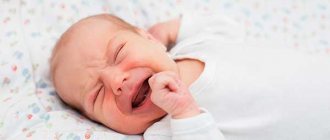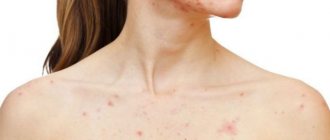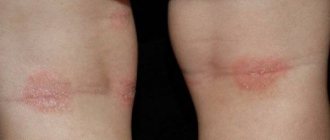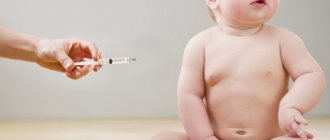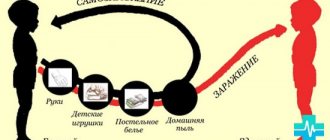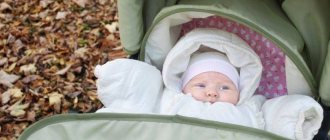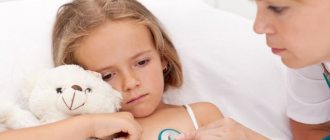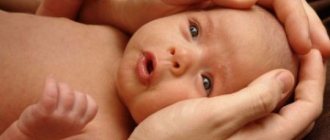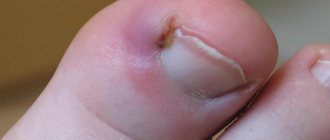Pregnancy, children > Caring for a newborn > Rough skin in infants: the main causes of pathology
Most mothers begin to panic when faced with a phenomenon such as rough skin on a baby, especially if this condition is pronounced.
The child's hands, head or feet may be rough.
Sometimes such symptoms are not dangerous, but in some cases they can pose a serious threat to the baby's health. Over time, this phenomenon can develop into a chronic form of the disease.
Causes of roughness
Rough skin on the face, accompanied by red rashes, is most often a consequence of acne in newborns. This condition is considered quite normal. It is caused by a large amount of hormones in the baby’s body. Parents should not worry, because within 1.5 or 2 months after birth this rash goes away.
If roughness on the skin appears in a baby after 2 months, and this condition is protracted, then this may be a sign of atopic dermatitis. It is accompanied by the appearance of dry spots. Atopic dermatitis is a condition in which the skin reacts to external irritants.
For example:
- Certain foods (mother's milk or formula)
- Washing powder and fabric softener
- Too dry air in the room
- Water in which they bathe a child or wash their clothes in it
- Other category of allergens (cosmetics, animal hair, medications, dust)
- Synthetic clothing
- Smoking of parents (tobacco smoke in the air of the apartment)
Peeling of the skin due to allergies can be local. For example, it occurs behind the ears in a baby. If a staphylococcal infection is added to this, then crusts and weeping appear, emitting an unpleasant odor. This condition may be associated not only with allergies, but also with improper child care. We are talking about a situation when a baby’s vomit after regurgitation flows into the area behind the ears and the mother does not remove it in time.
Roughness on the baby’s skin can also occur after a walk in frosty, windy weather. The negative external environment most often affects exposed parts of the body (baby’s face and hands).
Therefore, before every trip outside, mothers must lubricate the baby’s cheeks with a protective, rich baby cream. You should pay attention to the fact that it does not contain water or fragrances.
Read: Why does a baby's stomach hurt?
Main characteristics of healthy baby skin
Soft, delicate, velvety - this is how we usually talk about a baby’s skin. But even if the child is healthy, it does not become so immediately after birth.
Why? Explains Alexander Prokofiev, dermatovenerologist, medical expert at La Roche-Posay: “After the baby is born, his skin needs to adapt to the environment. In newborns, this process has not yet been completed, so their skin is more dry, more susceptible to irritation, redness, and easier to injure. These features disappear with age.”
Typically, by the age of two, the upper stratum corneum of the epidermis thickens, and the skin becomes more protected from external influences. The sebaceous and sweat glands begin to work more actively, and the process of thermoregulation gradually normalizes.”
Normally, a child’s skin should be pale pink and have good turgor, that is, be soft and elastic to the touch.
Bathing water should not be too hot © iStock
Doctors' advice
Treatment should be prescribed by a specialist after examination.
Only a specialist in a medical institution can find out what the true reasons for the appearance of roughness on the baby’s skin are, as well as make the correct diagnosis. Parents should make every effort to alleviate the baby’s condition before receiving test results.
To do this, it is advisable to completely remove from the room in which the baby is located all possible sources of allergies (stuffed toys, a canopy located above the baby’s crib, carpets, etc.). It is necessary to limit the child’s contact with pets.
You should walk with your baby as often as possible and ventilate the room. When the heating season begins, it is recommended to use special air humidifiers or use other methods.
It is recommended that the mother keep a food diary and write down in it exactly what foods the child ate (or she, if the child is breastfed). In this case, it will be immediately clear what food product caused the baby’s skin to peel off.
It is best not to bathe your baby every day. It is advisable to do this once every two days. Pediatricians recommend using boiled water for this purpose, rather than running water with chlorine from the tap. In addition, the same water should be used to rinse children's clothes after washing. Bleach can cause dryness and flaking of the skin.
In order to prevent this phenomenon, it is recommended to use baby cream or moisturizing milk after bathing. Bepanten has a good effect, with a regenerating and calming effect.
To prevent peeling from exposure to wind, it is recommended to apply rich baby cream to the baby’s cheeks every time before a walk. In this case, you need to ensure that there is no water in the composition of such a product.
All of the tips listed will help you get rid of roughness on your child’s skin very quickly.
Read: Newborn toilet. Shall we wash ourselves?
How to eliminate dry skin
Use moisturizing creams, lotions or body milk made specifically for children's skin. On such products it is always written what age they are intended for.
The water for bathing the baby should not be hot. The optimal temperature for the bath is 36–37 degrees.
Bathe your child every day, but use detergents no more than once a week. Choose special delicate formulas for this.
Moisturize dry areas with baby cream, milk or lotion.
An important condition against dry skin in children is the drinking regime © iStock
Treatment with medications
Proper care is the key to a child’s health
If the cause of peeling on the skin is atopic dermatitis, then only a pediatrician can treat it! You cannot do this on your own. In order to remove toxic substances from the baby’s body, sorbents (Enterosgel, Smecta, etc.) are used. If the baby is breastfed, then the mother should take the medicine.
To treat rough spots, the doctor usually prescribes Fenistil. Ointments and creams that contain glucocorticosteroids are prescribed to infants only by an allergist. Moreover, if the lesions on the skin are superficial, creams are used, and for deep lesions, ointments are used.
It is unacceptable to change the duration and dose of prescribed medications on your own. The drug should be discontinued over several days, gradually. In this case, the specialist will reduce not only the concentration, but also the dose of the cream or ointment.
For this purpose, the drug is mixed with baby cream in a certain proportion, which was established by a specialist in a medical institution. Then, little by little, the amount of medicinal ointment is reduced, and the portion of baby cream is increased.
Ointments based on glucocorticosteroids remove roughness on the skin, as well as red spots, in a very short time. But you should know that such drugs do not remove the internal cause of atopic dermatitis, but only remove external signs.
If the underlying cause of the disease is not treated, peeling along with spots may appear in other or the same places on the baby.
Parents must remember that in order for the roughness on the baby’s skin to completely disappear and no longer remind of itself, if such a problem appears, they should contact a medical facility as soon as possible. The specialist will conduct the necessary diagnostics and prescribe the correct treatment.
The video contains information for parents:
Read: How to correctly measure a newborn's body temperature
17 Dec 2021 Yuki 378
Share this post
We recommend reading along with this article
- How to make a children's room with a unique and inimitable design
- Atopic dermatitis in infants: photos, symptoms, causes...
- Atopic dermatitis in infants: symptoms, diagnosis, treatment
- Rash on the buttocks of a child: studying the nature of childhood rashes
- How to choose the right toys for babies
- Rules for caring for a newborn, carrying out the necessary…
- Feeding, sleeping, staying awake in the mode of a 2 month old baby
- Itchy buttocks: causes and treatment of itching
- How to treat a cough with sputum in a child - folk...
Discussion: there is 1 comment
- Faith:
10/14/2017 at 12:54We saw an allergist-immunologist because of peeling skin on the scalp, as in the article, and weeping cracks under the knees. They did a series of tests for food allergies, and there were none. The doctor's conclusion: this is a reaction to tap water. Recommendations: bathe in cool water 32-34 degrees, no more than 5 minutes, leave the water for 2 hours before bathing. A week later the problem was resolved.
Answer
What does dry skin mean in a child?
Very dry baby skin is a cause for concern. It is more vulnerable, easily injured, and damaged skin is more susceptible to infections, especially in infancy.
In addition, dryness may indicate the presence of:
ichthyosis (a disorder of keratinization of the skin, which manifests itself in the form of scale formation);
other diseases, including diabetes.
If dryness is a persistent feature of your child's skin, it makes sense to first consult with your pediatrician and then see a dermatologist for appropriate treatment.
Tools Overview
Milk for very dry skin Lipikar Lait, La Roche-Posay
Formula with shea butter, thermal water and niacinamide nourishes the skin and restores its lipid barrier. Suitable for use in infants, children and adults.
Skin cleansing gel Lipikar Gel Lavant, La Roche-Posay
Contains shea butter and niacinamide and is free of fragrance and parabens. Has skin-soothing properties, suitable for the whole family.
Children's skin is always soft and smooth, but sometimes it becomes dry and rough, which cannot but worry parents. They have to determine the reason why a child has dry skin at one year of age or older, and then eliminate it on their own or with the help of doctors. We will look at the main causes and methods of effective treatment.
Do I need to see a doctor if my child has dry and flaky skin?
Any pediatrician will tell you exactly why your child has very dry skin and what to do. Do not hesitate to ask your doctor questions; after all, we are talking about the baby’s health. The disorder is not always caused by improper care or allergies, but sometimes the cause is the dangerous diseases mentioned above.
To prevent further development of the disease and worsening dry skin, you should consult a doctor. The specialist will conduct a general diagnosis and, if necessary, prescribe a specialized examination. After identifying the root cause, the pediatrician will prescribe appropriate treatment and medications if necessary, and will also tell you what vitamins to take if your child has very dry skin.
When a child has dry body skin and the causes have been established, the doctor selects a suitable medication. Many parents buy creams containing urea at pharmacies, but sometimes they do not help. The pediatrician must select the concentration of the active ingredient. For example, a cream containing 5% urea is not suitable for children under 10 years of age. High concentrations of the component cause pain. Children require creams with minimal urea content.
An important role is played by the seasonality of the manifestation of the disorder and its root causes. Sometimes doctors are forced to take into account the individual characteristics of the body, so they need to be especially careful when taking medications.
When very dry skin is detected in a child aged 5 years or older, doctors often prescribe Excipial-M, which is sold in pharmacies in the form of a hydro- or lipo-lotion. The urea content in it varies, so the drug should be prescribed by a pediatrician.
Additionally, to eliminate the baby’s dry skin, it is necessary to treat the initial disease that triggered the development of dryness.
What to do if children have dry skin in winter
Quite often, the causes of dry skin in children are related to the time of year. The symptom appears in the autumn-winter period, when the weather outside is windy and frosty. Even babies at 1, 2 or 3 years old experience excessive dry skin, to combat which parents need to adhere to a few simple rules:
- Humidifying the air in the house where the baby is. If you don’t have a special humidifier, you can throw wet towels over the radiators: this simple method will help maintain an optimal level of humidity in the apartment even when the radiators are on.
- Regular moisturizing. After bathing, it is recommended to moisturize the child’s body with a high-quality balm or other cosmetic product. It is necessary to choose hypoallergenic products that do not irritate the delicate skin of babies.
- Drinking enough. You can get rid of dry skin in a child at 6, 7, 8 years old or another age by teaching him to regularly drink enough fluid.
- Vitamins. Make sure that your child gets enough vitamins from food or as part of additional multivitamin complexes.
To summarize, we will give some useful recommendations to parents. Dryness in a child 1.5 years old and older is an unpleasant phenomenon that needs to be dealt with. Treatment should not be started even if you find dry skin on a child’s cheeks or on another small surface of the body. The sooner you contact your pediatrician, the easier and faster the treatment will be.
